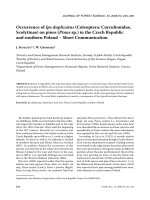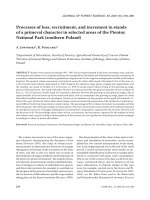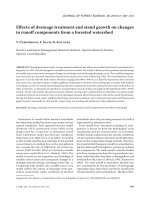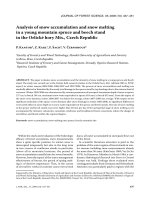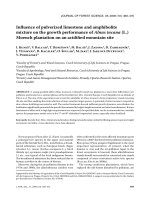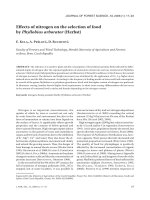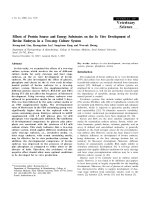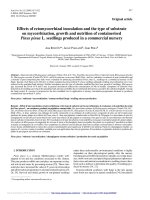Báo cáo lâm nghiệp: "Effects of drainage treatment and stand growth on changes in runoff components from a forested watershed" pps
Bạn đang xem bản rút gọn của tài liệu. Xem và tải ngay bản đầy đủ của tài liệu tại đây (487.75 KB, 7 trang )
J. FOR. SCI., 56, 2010 (7): 307–313 307
JOURNAL OF FOREST SCIENCE, 56, 2010 (7): 307–313
Generation of runoff within forested watersheds
has often been studied for many years under various
natural conditions. Šach reported Horton’s model
(H 1933) constructed in the 1930’s as the
design used for a long time to determine runoff
from watersheds under forested-site conditions
(K et al. 2003; Š et al. 2003). According
to this model, runoff is generated due to the gradual
concentration of overland flow as the precipitation
rate exceeds the rate of infiltration (S,
A 1992). In 1967, H devised a variable
source area model (H, H 1967). e
model is based on the expansion and shrinkage of
variable source areas and consequent changes in a
drainage network during a discharge event (Fig. 1).
Comparing both models, the variable source area
model reflects the nature of discharge event gen-
eration much better under conditions of forested
watersheds since the prevailing amount of runoff is
represented by subsurface flow.
Total runoff from watershed including its com-
ponents is driven by both the hydrological cycle
constituents and the characteristics of watershed.
Neither human-induced nor site-specific conditions
are necessarily leading to the total runoff alteration,
however the components change certainly. erefore
if we need to find changes in runoff in a watershed us-
ing the total runoff investigation, we have to evaluate
the components. e total runoff is usually divided
into three components: base flow (groundwater out-
flow), subsurface flow (interflow or throughflow) and
overland flow (B 1991a,b, 1993; T
2003). e total runoff is sometimes divided into
two constituents by the procedure of hydrograph
separation: basic (base flow) and direct runoff (sum
of both interflow and overland flow). e direct flow
Effects of drainage treatment and stand growth on changes
in runoff components from a forested watershed
V. Č, F. Š, D. K
Forestry and Game Management Research Institute, Opočno Research Station,
Opočno, Czech Republic
ABSTRACT: Runoff generation under various natural conditions has often been studied in forested watersheds for a
long time. In 1967, Hewlett designed a variable source area model. e model is based on the expansion and shrinkage
of variable source areas and consequent changes in a drainage network during a discharge event. e runoff investigation
was carried out in a forested watershed situated in the summit area of the Orlické hory Mts. e watershed has a drain-
age area of 32.6 ha with the land-surface elevation ranging from 880 to 940 m a.s.l. Runoff components, their amounts
and ratios were calculated using a simple graphical-mathematical method of the hydrograph recession limb analysis
according to a reservoir model representing the particular components (base flow, subsurface flow and overland flow, in
other words slow, accelerated and rapid flows). Comparing the amount of slow and rapid runoff constituents (89.5–99.4%
and 0.6–10.5%, respectively), the greater amount of slowly moving water confirmed that overland flow was absent under
conditions of forest environment. Not even the drainage treatment altered this positive ratio of the runoff constituents.
During the third period, under stabilized hydrology and stand conditions, the accelerated and rapid runoff increased
again, however maximally by 10% and 4%, respectively, not reaching the initial size of the calibration period.
Keywords: drainage treatment; forested watershed; recession limb; runoff components; stormflow hydrograph
Supported by the Ministry of Agriculture of the Czech Republic, Projects No. MZE 0002070203 and QH92073.
308 J. FOR. SCI., 56, 2010 (7): 307–313
is considered as the amount of precipitation minus
interception, infiltration, evaporation and storage
losses (H 1988; K 1996).
First, the effects of drainage treatment and stand
growth on changes in runoff were analyzed and in-
terpreted employing the frequencies of mean daily
streamflows and master hydrograph falling limbs
– simple modelling recession and depletion curves
(Č 2006b; Č, Š 2007), then
using the unit hydrograph method (Č,
K 2009). In the present paper, we articulate this
principal research question: Do both the drainage
treatment and the growth of young forest stands affect
the constituents of total runoff in the watershed?
MATERIALS AND METHODS
Study area
e U Dvou louček (UDL) study area is a small
forested watershed situated in the summit part of the
Orlické hory Mts., East Bohemia (Š et al. 2005;
Č 2006a). e watershed has a drainage
area of 32.6 ha with the land-surface elevation rang-
ing from 880 to 940 m a.s.l. Soils in the UDL study
area are classified as Podzols and Cambisols derived
from the gneiss and mica schist bedrock; there was
also found a small patch of peaty Gleysol. e for-
est site belongs to the spruce with beech vegetation
type situated on acidic, waterlogged and locally peaty
soils. e total thickness of Quaternary unconsoli-
dated material (sandy and clayey soil with 20–50%
amount of coarse fraction) ranges from 1 to 2 m.
Soils formed under such conditions are mostly well
drained except the Gleysol patch, which is affected
by a rising water table. e waterlogged area occurs
above the gneiss-mica schist tectonic boundary act-
ing as a hydraulic barrier. ere were found many
natural springs near tectonic faults as well.
Long-term average annual precipitation is
1,350 mm, discharge 910 mm and evaporation
440 mm. A stream discharging into the watershed
is a tributary of the Anenský potok brook. Average
annual air temperature is 4.4°C. Because of locally
waterlogged soils, drainage treatment was conducted
in order to restore discharge conditions in the wa-
tershed. In 1996, drainage ditches were dug to meet
the following requirements in the core area of the
watershed of approximately 3 ha, i.e. to drain surplus
water away from waterlogged patches, to restore
natural streams and to interrupt discharge through
artificial channels formed by logging machinery
(ČSN 75 0140; ČSN 75 4306; ČSN 75 4200; H-
1995; ČSN 75 0146). e ditches (60–70 cm in
depth) are situated within the 3 ha core area in the
middle of the watershed.
Experiment performance and data assessment
Runoff is divided into components. eir amount
and ratios are calculated using many mathemati-
cal and graphical-mathematical methods. We have
chosen a simple analysis of the recession (falling) hy-
drograph limb (Drainage 1973; L et al. 1975;
C et al. 1988; S 1998). is method is
based on Boussinesq’s linear reservoir (B
1904) and Kraijenhoff’s reservoir (K
L 1958) including their dividing system
representing the particular components of total run-
off, i.e. base flow, subsurface (storm)flow (interflow,
throughflow) and overland (storm)flow, in other
words slow, accelerated and rapid flow.
e time series of the investigation were divided into
particular periods in order to calculate the mean unit
hydrograph comparison using double-mass curves of
both runoff and precipitation. e annual rainfall-run-
off ratio is nearly constant under temperate climatic
conditions during a year. In other words, the ratio
provides a straight line for long-term periods. e
double-mass curve method helps verify the stability of
Fig. 1. Illustration depicting the theory of variable source areas
(S, A 1992) generating subsurface flow in
a small forested watershed. e picture shows a periodical
variability of the runoff generation. Black area is a permanent
stream runoff source. Horizontally-hatched areas generate
runoff seasonally in late winter, spring and early summer. Areas
enclosed with a dashed line act as source areas only during wet
periods rich in precipitation. e only periods when the whole
area of watershed generates runoff are heavy-rainfall events
for several days or during snow melting
J. FOR. SCI., 56, 2010 (7): 307–313 309
natural conditions of the study area. If the line changes
its form (slant), a cause is to be found in the particular
year (e.g. inhomogeneity of data caused by recording
equipment, road-construction disturbance including
drainage treatments, land-use management within
the watershed and climate) (Š et al. 2004).
The data collected during the investigation
provide the following information. e investiga-
tion span includes three periods reflecting runoff
changes: first – a calibration period represents
runoff conditions before drainage treatment (water
years 1992–1995), second – post-drainage period
(1996–2001) and third – period of forest stand hy-
drology restoration (2002–2005).
e periods were determined using the construc-
tion of double-mass curves describing rainfall-runoff
ratios for both growing and dormant seasons and
for water years. e change in the trend that was
found in growing seasons in 1996 and 2002 helped
to determine the post-drainage period typical of
increased runoff (Fig. 2). On the other hand, the
restoration period (2002–2005) was determined
using a comparison with the calibration (pre-treat-
ment) period; the trends of double-mass curves for
both periods were nearly identical at the 95% sta-
tistical significance level suggesting a restoration of
the runoff coefficient value back to the initial level.
Similar trends were found by K et al. (2003)
and B et al. (2005), though they were interested
in clearcut-induced runoff. e restoration was con-
sidered as subsequence reflecting the development
of regenerated forest stand. Under such conditions,
the fluctuation of runoff can be related to the loss and
restoration of both interception and transpiration.
On the other hand, the drainage-induced change led
to different runoff situation persisting till the drain-
age system efficiently worked. However, we suppose
that both vegetation and drainage ditches influence
runoff from the UDL study area as synergy factors.
More than 80% of the area cover was a young spruce
thicket which influenced runoff due to the uptake of
water and transpiration. Also flowpaths of infiltra-
tion are multiplied due to extending roots as water is
driven to percolate along them. Rainfall water enters
the forest soil and percolates through large pores
allowing soil water to move faster in both saturated
and unsaturated profiles (S 1980; N
2005). erefore, the third-period runoff did not rep-
resent a restoration of initial conditions but it most
likely showed stabilization at new a level resulting in
double-mass curve similarity (of its slant).
We chose 76 suitable discharge events from
summer water half-years (with distinct inflection
points on the hydrograph falling limb and without
excessive fluctuation caused by marginal precipita-
tion events) to separate the runoff components.
In particular, 11 belong to the calibration period,
37 to the period after draining treatment and 28 to
a subsequent period with stabilized hydrological
and silvicultural conditions. e years of break were
determined using the double-mass curve method.
Hydrograph analysis of the stormflows was done by
separating single runoff components (groundwater
outflow, subsurface and surface runoff). e runoff
amount of separated components was calculated
and percentage in total runoff was expressed. e
amount of surface (rapid), subsurface (accelerated)
and groundwater (slow) discharge was assessed for
stormflow events before and after drainage network
reconstruction. Besides, the influence of growing up
spruce thicket was also taken into account, because
both the drainage system reconstruction and the
forest stand regeneration represented changes in
conditions for runoff generation. A graph resulting
from the recession limb analysis shows a discharge
event on the 14
th
July 1999 (Fig. 3).
e overland flow is nearly negligible under for-
ested-site conditions (K 1983, 1984a,b; Š
et al. 2000; K et al. 2003), therefore water
moves mainly through soil as so called subsurface
lateral flow. is is the main reason why we preferred
the following terminology expressing the total runoff
Fig. 2. Double-mass curve of
summer water in 1992–2005
0
1,000
2,000
3,000
4,000
5,000
6,000
0 2,000 4,000 6,000 8,000 10,000
Runoff (mm)
Precipitation (mm)
Summer (W. y. 91/92 to 04/05)
double-mass curve
1992
1996
2002
2005
310 J. FOR. SCI., 56, 2010 (7): 307–313
components: slow flow, accelerated flow and rapid
flow.
We found a strong relationship between the runoff
amount and the peakflow rate, therefore discharge
events could be divided into three different groups.
Each data set represents the extent of peak discharge
events, partially related to the division of mean daily
discharge reflecting runoff generation and advance.
According to the mean daily discharge frequency,
these three data sets represent a small discharge
of low peakflow rates with the highest frequency,
medium discharge of various peakflow rates with
variable frequency and the least frequent high peak
discharge of large volume. According to the theory of
variable source areas (H, H 1967) and
amount of excess rainfall, these data sets represent:
small-volume and low-intensity precipitation related
to the active variable area near streams, medium-vol-
ume precipitation of fluctuating intensity activating
different number of source areas at various distances
from streams, large-volume precipitation often of
high-intensity activating all source areas within the
watershed. e range of peakflow rates of the three
data sets was determined as follows: less than 20 ls
–1
,
20–60 ls
–1
, more than 60 ls
–1
.
RESULTS AND DISCUSSION
Existing investigations (e.g. H 1980;
W et al. 1993; L 1994; N
1994; A et al. 1996), dealing with draining
waterlogged forest catchments and growing stands
in relation to runoff, assessed total runoff and its
extremes in the progress of time. Unlike them we
dealt with dividing the runoff into components
using the analysis of hydrograph by separation its
recession limb and determining only the runoff con-
stituents and their comparison also in the process
of time. Similarly, the influence of land use changes
on the ratio of runoff components (surface runoff
and subsurface water recharge) for small forested
catchments was observed and modelled simulating
scenarios by K (1998).
e constituents of runoff and their changes were
expressed in percentage (Fig. 4). The discharge
events typical of peakflow rates less than 20 ls
–1
are
in accordance with the above-mentioned way the
runoff is generated in variable source areas. e pro-
portion of both rapid (R
ra
) and accelerated (R
ac
) run-
off (R
ra
+ R
ac
= 24.4%) detects a low-runoff variable
source area typical of runoff generated from water-
saturated soil layers situated near streams (near-
stream saturated zones) and water-logged patches
occurring before drainage treatment (less than 1/6 of
the total watershed area). e slow runoff (70–90%)
compared to other data sets with higher peak flow
seems to be permanently supplied with groundwater
outflow from more distant source areas.
Moreover, the drainage treatment increased
dynamic retention of precipitation in soil, i.e. fall
of water table and aeration of soil leading to its
moisture change. Consequently the accelerated
runoff decreased by 3.9%; in fact the rapid runoff
disappeared (the value dropped from 10.5% to
0.6%). Subsequently the water resided in soil was
released to increase the slow runoff constituent by
13.8%. Later on during the third, hydrology and
stand-stabilized period both rapid and accelerated
runoff constituents increased again. We attributed
the altered runoff constituents to improved soil po-
rosity due to the growth of forest stand (T
2004). Some authors also reported that growing
roots play an important role in the process of for-
mation of preferential flowpaths for water (S
1980; K et al. 2003; N 2005). e
former constituent increased to 4.7% representing a
lower level compared to the period before drainage
(10.5%). On the other hand, the latter one increased
Fig. 3. Separated runoff constituents
resulting from the recession limb
analysis, hydrograph is from 14
th
January 1999
-3.0
-2.5
-2.0
-1.5
-1.0
-0.5
0.0
1 4 7 10 13 16 19 22 25 28 31 34 37 40 43 46 49
Hour
log
log R
log Rsl
log (Rac + Rra)
log Rac
log Rra
log R
log R
sl
log (R
ac
+ R
ra
)
log R
ac
log R
ra
0.0
–0.5
–1.0
–1.5
–2.0
–2.5
–3.0
log
(h)
J. FOR. SCI., 56, 2010 (7): 307–313 311
Q
m ax
to 20 l·s
–1
13.9
75.6
10.5
0.6
89.4
10.0
4.7
23.9
71.4
0
10
20
30
40
50
60
70
80
90
100
slow accelerated rapid
Runoff
(%)
1992–1996
1996–2001
2002–2005
substantially compared to the period after drainage
(by 13.9%) and calibration period (by 10.0%).
Even though runoff was found to be accelerated,
water moves through soil being many times slower
compared to surface conditions (Š et al. 1992;
K et al. 1996; K et al. 2003). e slow
runoff constituent decreased by 18.0% compared to
the period after treatment and by 4.2% compared to
the calibration period to 71.4% of total runoff.
e set of hydrographs depicting peakflow rates
between 20 and 60 ls
–1
characterizes various pre-
cipitation-input conditions influencing the number
and size of active source areas. ese hydrographs
represent a middle-runoff interval typical of an-
nual variability of discharge amounts. Compared
to lower peakflow rates being less than 20 ls
–1
, the
above-mentioned set of hydrographs shows a lower
proportion of slow runoff (65–80%), higher propor-
tion of accelerated runoff (17–30%) and a little lower
proportion of rapid runoff (2–4%). e higher pro-
portion of accelerated runoff indicates the runoff of
increased precipitation from more distant variable
source areas via subsurface lateral flow.
e drainage treatment influenced runoff condi-
tions in terms of decreasing both accelerated and
rapid constituents (by 11.6% and 2.2%, respectively)
while the retention and slow runoff constituent in-
creased (by 13.8%) during the period after treatment.
e preferential flowpaths were likely to induce simi-
lar changes (amounts of runoff constituents) during
the hydrology and stand-stabilization period, i.e. for
peakflow rates less than 20 ls
–1
(accelerated and rapid
runoffs increased by 10.0% and 2.2%, respectively
while the slow constituent decreased by 12.1%). For
peakflow rates between 20 and 60 ls
–1
, we found an
obvious similarity in the percentage of runoff con-
stituents in both the calibration and the hydrology
and stand-stabilization periods (Fig. 4) being also
confirmed by double-mass curve analysis.
e least frequent high-precipitation discharge
events (peakflow rates over 60 ls
–1
) activating all var-
iable source areas within the watershed characterize
the distribution of particular runoff constituents,
i.e. 53–62% slow runoff, 35–45% accelerated runoff
and 5–9% rapid runoff. Both drainage-induced and
stand-induced changes are detectable even for high-
peakflow events being similar to low-peakflow ones
(less than 20 ls
–1
) though not so conspicuous. e
highest proportion of accelerated runoff proves that
a high amount of precipitation water moves through
the soil profile via lateral flow from more distant
source areas.
The overland flow is considered absent under
conditions of forested environment; it is proved that
the slow and accelerated subsurface runoff is propor-
tionally higher (89.5–99.4%) compared to the rapid
Fig. 4. Slow, accelerated and rapid runoff constituents expressed
as a percentage of total runoff in calibration (1992–1996), after
drainage (1996–2001) and hydrology-stabilized (2002–2005)
periods calculated using the recession limb analysis for dis-
charge event culminations less than 20 ls
–1
; 20–60 ls
–1
and
exceeding 60 ls
–1
Q
max
20–60 l·s
–1
66.6
29.2
4.2
80.4
17.6
2.0
68.3
27.6
4.2
0
10
20
30
40
50
60
70
80
90
slow accelerated rapid
Runoff
(%)
1992–1996
1996–2001
2002–2005
Q
max
more than 60 l·s
–1
54.8
36.1
9.1
61.7
33.4
4.9
53.2
39.9
6.9
0
10
20
30
40
50
60
70
slow accelerated rapid
Runoff
(%)
1992–1996
1996–2001
2002–2005
Q
max
to 20 l·s
–1
Q
max
more than 60 l·s
–1
Q
max
20–60 l·s
–1
312 J. FOR. SCI., 56, 2010 (7): 307–313
runoff constituent (0.6–10.5%). is positive ratio was
found even after the drainage treatment. Moreover,
the rapid runoff was nearly eliminated (0.6%) during
the low-peakflow events and this constituent also de-
creased by 2.2–4.2% during higher peakflows.
CONCLUSION
e results showed hydrographs expressing altered
runoff in the watershed. e changes were influenced
by both the drainage treatment and the forest stand
growth. e concurrence of both events increases
peakflow while the runoff amount in the recession
limb of hydrograph decreases. We suppose an in-
creased suction effect of the growing forest stand as
the forest turns to small-pole and last-growth stages.
e runoff components separated using the analysis
of the recession limb hydrograph of U Dvou louček
watershed origin are in accordance with the vari-
able source area method (H, H 1967;
K et al. 2003; Figs. 2 and 4). Increased amount
of precipitation, larger source areas and longer travel
time to the stream led to an increased part of lateral
discharge through the soil. Comparing the amount of
slow and rapid runoff constituents (89.5–99.4% and
0.6–10.5%, respectively), the greater amount of slowly
running water confirms that overland flow is absent
under conditions of forest environment. Not even the
drainage treatment has altered this positive ratio of the
runoff constituents. On the contrary, the rapid runoff
diminished (0.6%) during the low-peakflow events
and also decreased by 2.2–4.2% during the greater
ones. During the third hydrology-stabilized period
the forest stand growth led to an increased number of
preferential flowpaths due to the growth of roots (S-
1980; K et al. 2003; N 2005); the
accelerated and rapid runoff increased again, however
maximally by 10% and 4%, respectively, not reaching
the initial level of the calibration period.
Referen ce s
A B., F J., B K. (1996): Application of a
generalized TOPMODEL to the small Ringelbach catch-
ment, Vosges, France. Water Resources Research, 32:
2147–2159.
B M., J M., O Z., V Z. (2005):
Rainfall-runoff relations in the Beskids Mts. experimental
watersheds. In: Š M., L Ľ., T M., H L.
(eds): Hydrology of a Small Watershed 2005. Praha, Ústav
pro hydrodynamiku AV ČR: 12. (in Czech)
B Š. (1991a): Review of world experience with the
effect of deforestation on rainfall caused stormflow. Vodo-
hospodársky časopis, 39: 69–94. (in Czech)
B Š. (1991b): Modelling the changes of rainfall caused
peak flows due to deforestation by the method of scenarios.
Vodohospodársky časopis, 39: 97–115. (in Czech)
B Š. 1993): Rainfall-runoff Modelling Based on the
Principle of a Unit Hydrograph. Práce a studie, sešit 183.
Praha, Výzkumný ústav vodohospodářský T. G. Masaryka:
114. (in Czech)
B J. (1904): eoretical research on the flow of
underground water infiltrated in soil and the capacity of
sources. Journal de Mathématiques Pures et Appliquées,
10 : 5–78. (in French)
Č V. (2006a): Influence of hydrographic network
damaged during air-pollution felling on drainage process.
[Ph.D. esis.] Praha, Česká zemědělská univerzita v Praze:
102. (in Czech)
Č V. (2006b): Influence of hydromeliorative
treatment on runoff from forest watershed. In: J
A., N J., S M. (eds): Stabilization of Forest
Functions in Biotopes Disturbed by Anthropogenic Activity.
Research results presented on international scientific con-
ference. Opočno 5.–6. September 2006. Jíloviště-Strnady,
Výzkumný ústav lesního hospodářství a myslivosti – Výz-
kumná stanice Opočno: 545–557. (in Czech)
Č V., Š F. (2007): Renewal of the hydrographical
network damaged by pollution-induced felling and its effect
on the runoff process. In: V K., B J., B M.,
Č J., Č V., F V., F B.,
H P., H V., H J., H H., J J.,
K P., K P., K M., K V., K J., L-
V., M J., O Z., P V., P-
K., P A., S J., Š F., Š L., Š P.,
Š V., V Z.: Forest and Water in the Heart of Europe.
Praha, Brandýs nad Labem, MZe ČR, ÚHÚL: 185–193.
Č V., K P. (2009): Forest watershed runoff
changes determined using the unit hydrograph method.
Journal of Forest Science, 55: 89–95.
ČSN 75 0140 Water management. Terminology of ameliora-
tion. Praha, ČSNI 1988. (in Czech)
ČSN 75 0146 Forest engineering amelioration Terminology.
Praha, ČSNI 2000. (in Czech)
ČSN 75 4200 Hydrotechnical meliorations. Regulation of
water regime of agricultural soils by draining. Praha, ČSNI
1994. (in Czech)
ČSN 75 4306 Hydrotechnical meliorations. Drainage channels.
Praha, ČSNI 1993. (in Czech)
Drainage (1973): Principles and applications. Part II – eo-
ries of drainage and watershed runoff. Wageningen, Interna-
tional Institute of Land Reclamation and Improvement.
H Z. (1995): Draining of forest soil in the U Dvou
louček locality. Project of the Hartman’s firm. Hra-
dec Králové, firma Hartman – projektování vodních a
inženýrských staveb. (in Czech)
H L. (1980): Effect of forest drainage on high
discharge. In: Proceedings of the Helsinki Symposium on
J. FOR. SCI., 56, 2010 (7): 307–313 313
e Influence of Man on the Hydrological Regime with Spe-
cial Reference to Representative and Experimental Basins,
Helsinki, June 1980. Wallingford, International Association
of Hydrological Scientists: 89–96.
H J.D., H A.R. (1967): Factors affecting the
response of small watersheds to precipitation in humid
areas. In: S W.E., L H.W. (eds): Forest Hydrol-
ogy. Proceedings of an International Symposium. Oxford,
Pergamon Press: 275–290.
H R.E. (1933): e role of infiltration in the hydrologi-
cal cycle. Transactions of the American Geophysical Union,
14: 446–460.
H F. 1988: Hydrology. Praha, Vysoká škola zemědělská:
370. (in Czech)
C V.T., M D.R., M L.W. (1988): Applied
Hydrology. New York, McGraw-Hill: 572.
K P. (1983): Hydrologic efficiency of Norway spruce
and European beech stands within growing season. Les-
nická práce, 62: 6–12. (in Czech)
K P. (1984a): Components of water balance of forest
stands with regard to their function. In: Forest – Techni-
cal Ameliorations in the Czechoslovakia. Zvolen, Edičné
stredisko Vysokej školy lesníckej a drevárskej: 132–140.
(in Czech)
K P. (1984b): Water regulation function of mountain
Norway spruce and European beech stands. Lesnictví, 30:
471–490. (in Czech)
K M. (1996): Climatology, Meteorology, Hydrology.
Praha, České vysoké učení technické: 289. (in Czech)
K P. (1998): Water balance modelling on small forested
catchments. In: S K. (ed.): Proceedings of the IUFRO
Division 8 Conference. Kyoto University, Japan, 19.–23.
October 1998. Kyoto, Kyoto University: 405–410.
K L D.A. (1958): A study of non-
steady groundwater flow with special reference to a reser-
voir-coefficient: De Ingenieur, 70 : 87–94.
K V., K P., Š F., Š V., Č V.
(2003): Forests and Floods. Praha, Ministerstvo životního
prostředí: 48. (in Czech)
K M., K V., C M. (1996): Hydropedol-
ogy. Praha, České vysoké učení technické: 150. (in Czech)
L R.K., K M.A., P J.L.H. (1975): Hydrol-
ogy for Engineers. New York, McGraw-Hill: 496.
L L. (1994): Impacts of forest drainage on flow regime.
Studia Forestalia Suecia, 192: 22.
N M. (1994): Hydrology and the River Environment.
Oxford, Clarendon Press: 221.
N Z. (2005): Influence of biopores and water repel-
lency on infiltration of water into soil. In: Š M., L
Ľ., T M., H L. (eds): Hydrology of a Small Wa-
tershed 2005. Praha, Ústav pro hydrodynamiku AV ČR:
223–227. (in Slovak)
S D.R., A P.W. (1992): Wildland Watershed
Management. New York, J. Wiley: 436.
S R.C. (1980): Impact of forest practices on surface ero-
sion. In: A Pacific Northwest Extension Publication PNW
195. Eugene, Oregon State University: 15.
S J. (1998): Actual state of methodology of recession flow.
Praha, Český hydrometeorologický ústav: 27. (in Czech)
Š F., K P., Č V. (2000): Forest ecosys-
tems, their management by man and floods in the Orlické
hory Mts. in summer 1997. Ekológia, 19: 72–91.
Š F., Č V., K P. (2003): Mountain forests´
ability to reduce floods – results of measuring in terrain.
In: National Seminar on Forests and Floods. Praha, Česká
lesnická společnost: 17–29. (in Czech)
Š M., T M., L L. (2004): Climatic anomaly
1992–1996 in the Liz catchment in the Bohemian Forest as a
consequence of Pinatubo eruption in 1991. In: Proceedings
News of the Šumava Mts. Research II, Srní, 4.–7. October
2004. Srní, NP Šumava: 74–78. (in Czech)
Š V., D H., K J., Š O. 1992:
e Ovesná Lhota research object. Praha, Výzkumný ústav
meliorací a ochrany půdy: 156. (in Czech)
Š V., Č V., K Z., Š F. (2005):
Contribution to a hydrology analysis of “U Dvou louček”
experimental forest catchment in the Orlické hory Mts. In:
Soil and Water. Scientific Studies. 4/2005. Praha, Výzkumný
ústav meliorací a ochrany půdy: 95–105. (in Czech)
T D.G. (2003): Rainfall-runoff processes. A work-
book to accompany the Rainfall-Runoff Processes Web
module. Available at
(accesed 2009 June 17)
T L. (2004): Water Regime of Forest Soils. Zvolen,
Technická univerzita Zvolen: 102. (in Slovak)
W J.M., R N.T., H A.R. (1993): Runoff
mechanisms in a forested groundwater discharge wetland.
Journal of Hydrology, 147: 37–60.
Received for publication October 19, 2009
Accepted after corrections January 11, 2010
Corresponding author:
Ing. V Č, Ph.D., Výzkumný ústav lesního hospodářství a myslivosti, v.v.i., Výzkumná stanice
Opočno, Na Olivě 550, 517 73 Opočno, Česká republika
tel.: + 420 494 668 391, fax: + 420 494 668 393, e-mail:
